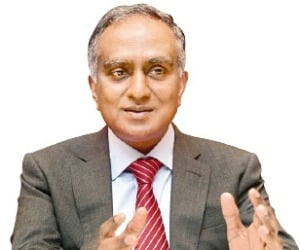[Interview] US mid-market debts to shine in weaker economy: Oaktree Capital
Aug 01, 2019 (Gmt+09:00)
S.Korea's LS Materials set to boost earnings ahead of IPO process


CarlyleŌĆÖs Rubenstein sees commercial real estate undervalued


Samsung Electronics' key M&A man returns; big deals in the offing


Money pours in for technology to reshape Korean restaurants


CJ CheilJedang to sell feed, livestock unit for $1.4 bn


The mezzanine financing market for US mid-sized companies remains illiquid in comparison to the crowded senior debt market, but junior debts in the middle market are offering attractive risk-adjusted returns with increased investment opportunities, said a senior manager of Oaktree Capital Management.
Mezzanine lending to US middle-market firms will increase if the decade-long US economic growth stutters. Underperforming borrowers are likely to refinance senior debts into junior notes, Raj Makam, co-portfolio manager of Oaktree CapitalŌĆÖs middle-market finance group.
ŌĆ£When investing in the middle market, you are investing in a market where there is illiquidity, but you are getting a higher premium,ŌĆØ he told the Korean Investors in a recent interview.

ŌĆ£Junior loans can be very attractive because you can refinance it at a nice premium. There is probably a lot more opportunity in junior in comparison to senior loans especially when the economy cracks,ŌĆØ he said during a visit to Seoul to meet clients.
Makam is in charge of mezzanine finance and middle-market direct lending strategies at the US-listed asset manager, and mainly focuses on investing in North America and the middle-market.
The spread in senior loans between upper-market and middle-market companies is less than 1% because of ample market liquidity.
In comparison, the spread in mezzanine loans is about 6%, with the fixed coupon rate for US middle-market mezzanine loans amounting to 11%.
The US middle market is composed of approximately 41,000 companies with EBITDAs from $10 million to $50 million and made up 33% of the US gross domestic product in 2012. Now the range is being narrowed to about $40 million, he said.
They have difficulty in funding from banks because of higher default risk than bigger corporations.
A big mismatch between the maturity of their assets and debts poses another risk which will intensify in a stuttering economy because of a limited pool of lenders in the segment, Makam added.
But if their default risk is managed properly, junior debts to US mid-sized companies will deliver decent returns with stability.
When asked about target companies for mezzanine financing, Makam said: ŌĆ£The best middle-market deal (is) where there is no outsourcing risk to Asia, no technology risk, no Amazon risk.ŌĆØ
The reason why he focuses on the US market is because of its stable regulatory environment with well-established bankruptcy law which guarantees the rights of mezzanine lenders taking default risk.
He cautioned that because the senior debt market has become crowded, many investors may not fully recognize senior risk.
Currently, over 60% to 65% of middle-market senior loans has leverage of over four times, which means two thirds of the market are still calling junior risk as senior risk, he said.
Oaktree Capital manages $119 billion in assets, of which US distressed investing and high-yield bonds make up 68%.
By Jung-hwan Hwang
jung@hankyung.com
Yeonhee Kim edited this article
-

-

-
 InfrastructureInfrastructure secondaries continue to rise amid inflation: Stafford
InfrastructureInfrastructure secondaries continue to rise amid inflation: StaffordApr 09, 2024 (Gmt+09:00)
-
 Private equityCarlyleŌĆÖs Rubenstein sees commercial real estate undervalued
Private equityCarlyleŌĆÖs Rubenstein sees commercial real estate undervaluedApr 08, 2024 (Gmt+09:00)
-



